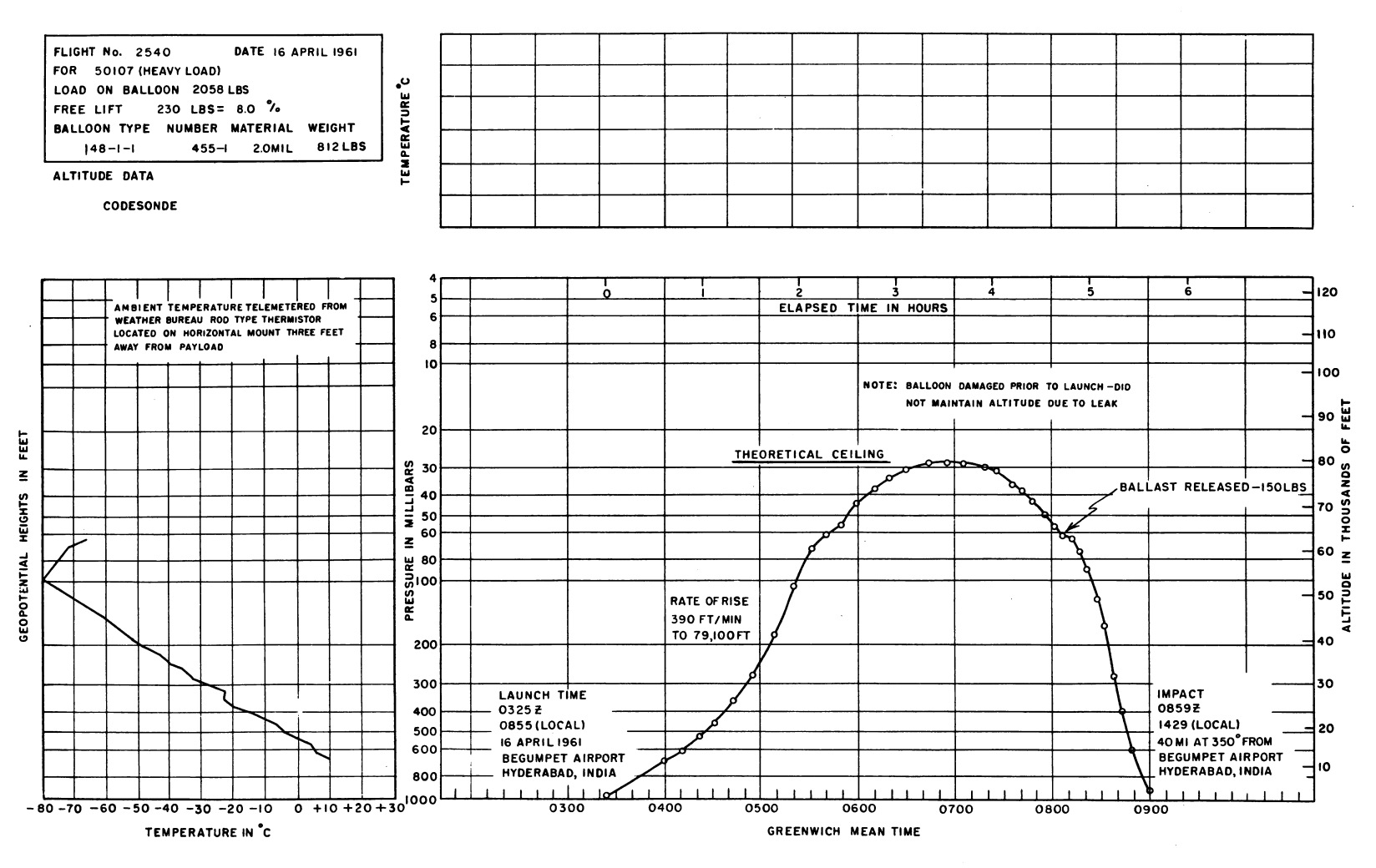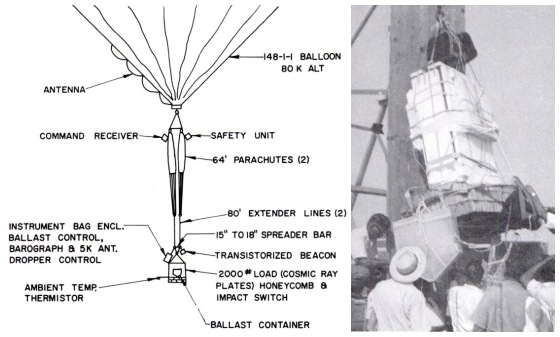Purpose of the flight and payload description
This flight was part of the Joint Indo-U.S. Balloon Flight Program - 1961 a cooperative scientific launch campaign carried out between February and April 1961 by scientists from India and the United States in Hyderabad, India. The objective of the extended series of high-altitude balloon flights was to probe the tropical stratosphere using a wide variety of scientific instruments.
The main goal of this particular flight was to study cosmic radiation by exposing a heavy nuclear emulsion stack for an extended period of time in the stratosphere. The emulsion-tungsten assembly with a weight of 2000 lbs, was part of a joint research programme on nuclear interactions at very high energies between the Tata Institute of Fundamental Research from India and the Bristol University from England. In accordance with arrangements made during negotiations for the program, this stack was to be flown on a U.S. balloon with Indian-furnished hydrogen lifting gas and to float for 24 hr at 80,000 ft. As the program progressed, it became apparent that sufficient helium would be available for this flight, making the operation that much simpler and less hazardous. At left we can see an scheme of the flight train along with an image of the emulsion pack before launch.
Aditionaly to the main payload, were also part of the flight train radiosondes provided by the India Meteorological Department (IMD) to measure temperature, humidity, electrical conductivity and/or potential gradient.
Details of the balloon flight

Balloon launched on: 4/16/1961 at 3:25 utc
Launch site: Begumpet Airport, Secunderabad, India
Balloon launched by: General Mills Inc.
Balloon manufacturer/size/composition: Zero Pressure Balloon General Mills 148-1-1 (2.0 mil)
Balloon serial number: 455-1
Flight identification number: GMI Nº 2540
End of flight (L for landing time, W for last contact, otherwise termination time): 4/16/1961 at 8:59 utc (L)
Balloon flight duration (F: time at float only, otherwise total flight time in d:days / h:hours or m:minutes - ): 5 h 34 m
Landing site: 40 Miles N of Hyderabad, India
During inflation of the balloon an accident occurred which ultimately resulted in flight failure. A truck was attached to the launch platform as an anchor to the system during inflation. When the platform was anchored to the truck the driver was told to set the brakes, leave the truck in gear, and turn off the ignition. Since a language barrier did, at times, existed between U.S. personnel and Indian personnel, misunderstandings were common throughout the entire campaign. In any case, the truck was neither in gear nor were the brakes set. As inflation continued, tension increased in the flight system to a point where the platform began to move toward the launch truck, pulling the anchor truck with it. The balloon, of course, rolled through the roller arm as the platform moved. A jack-knifing action between the platform and anchor truck began, which resulted in both units skidding to a sudden stop. This action ripped large holes in the balloon near the roller arm. The balloon was patched, using poly tape, but after 45 min of patching it was doubtful that the balloon would ever reach float altitude. Since there was a chance that the balloon might survive, the decision was made to go ahead with the operation.
Balloon was launched on April 16, 1961 at 8:55 local time from Begumpet Airport, near Secunderabad using dynamic method. Rate of rise was only 390 fpm and it was evident that helium was escaping. The balloon leveled off at 79.100 ft but, after approximately 30 min at this altitude, it began a slow descent. The entire 150 lb of ballast was released at 65,000 ft which only momentarily slowed the descent. Impact occurred 40 miles north of the launch site.
External references
- Joint Indo-United States Balloon Flight Program - 1961 Scientific Report - Air Force Cambridge Research Laboratories (U.S.) - 1962
3047If you consider this website interesting or useful, you can help me to keep it up and running with a small donation to cover the operational costs. Just the equivalent of the price of a cup of coffee helps a lot.


